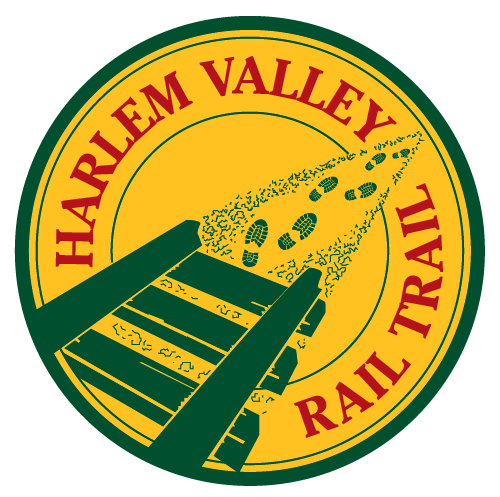
Ecology
The Harlem Valley Rail Trail has a wide variety of plant species growing along the trail. An extensive botanical survey of the trail was conducted and a four-color botanical brochure was published in August 2005. The brochure is free. You can pick up the brochure at kiosks along the trail or download it here.
Ducks, beavers, deer, and foxes are just a few of the animals that you might spot along the trail. Just remember that these animals are wild, and that while it is fine to respectfult look, please DO NOT attempt to feed or touch them.
Since the trail follows along the path of the former Upper Harlem Line of the Penn Central Railroad, the area has a rich history. Along the trail you can see former railroad stations and other relics of the past. An interpretive sign program is nearing completion. The signs will highlight railroad, community, and natural history. For now, please visit the individual trail section pages for more information on local history and the flora and fauna associated with each trail segment.
WildLife Sightings on the Harlem Valley Rail Trail
If you see any wildlife on the Harlem Valley Rail Trail, please let us know the date, time, location and comments you have of the sighting (pictures are welcome).
We will post your submission.
Please email us at: hvrta@taconic.net
Thank you for keeping us all informed of the wonderful sites to explore on our Rail Trail.
Below is a list of wildlife sightings that may been seen during certain dates throughout the season.
This information has been generously provided to us by Art Gingert.
Arrival of the first red-winged blackbirds on territories along the Trail, usually by February 20th if snow is melting or absent. Also Canada geese and mallards about the same time.
First wood frogs calling from woodland or vernal pools along the Trail (early to mid-March).
First spring peepers (by March 20th or end of month in cold year).
First chipmunks or later, woodchucks, up & out from hibernation.
Red foxes barking during mating season in February. Bobcats or bears along the Trail. River otters in the cattail marsh or along the Webatuck. First whitetail deer fawn seen.
Early wood warblers, like palm and pine passing through. First groups of yellow-rumped warblers, etc. and thrushes, vireos, and such. First wood thrush song in mid-to-late spring, since they nest along the trail (especially just north of Amenia trailhead) and are exceptionally beautiful.
First timber rattlesnake on the Trail, down from a highland den.
Likewise with blooming dates for well-known or even unusual wildflowers too, like wake robin, white trillium, dame’s rocket, etc. through spring & early summer and maybe fringed gentian in late summer, and the like. Also notable shrubs like spicebush along any watercourses in the early spring.Wildlife documented by a herpetologist and ecologist during 11 visits to portions of the trail in 2001-02 (some of these animals and insects are more common in certain areas than in others):
Meadow Vole (Microtus pennsylvanicus)
Eastern milk snake (Lampropeltis triangulum)
Eastern garter snake (Thamnophis sirtalis)
Common snapping turtle (Chelydra serpentina)
Eastern painted turtle (Chrysemys picta picta)
Spotted turtle (Clemmys guttata)
Wood turtle (Clemmys insculpta)
Short-tailed shrew (Blarina brevicauda)
White-tailed deer (Odocoileus virginianus)
Eastern cottontail (Silvilagus floridanus)
Woodchuck (Marmota monax)
Eastern Chipmunk (Tamias striatus)
Spotted salamander (Ambystoma maculatum)
Red-spotted newt
Northern two-lined salamander (Euxx bislineata)
American Toad (Bufo americanus)
Wood frog (Rana sylvatica)
Green frog (Rana clamitans melanota)
Pickerel frog (Rana palustris)
Gray treefrog (Hyla Versicolor)
Spring peeper (Pseudacris crucifer)
Baltimore Oriole (Icterus galbula)
Black-and-white warbler (Mniotilta varia)
American goldfinch (Carduelis tristis)
Wild turkey (Meleagris galopavo)
Canada goose (Branta canadenis)
American woodcock (Philohela minor)
Veery (Catharus fuscescens)
Virginia rail (Rallus limicola)
Red-winged Blackbird (Agelaius phoeniceus)
Tree swallow (Iridoprocne bicolor)
Cedar waxwing (Bombycilla cedrorum)
Common yellow throat (Geothlypis trichas)
Song sparrow (Melospiza melodia)
Gray catbird (Dumetella carolinensis)
Dragonfly nymph (Odonata)
Blue pirate (dragonfly) (Pachydiplax longipennis)
Twelve-spot skimmer (dragonfly) (Libellula pulchella)
Predaceous diving beetles (Dytiscidea)
Marsh beetles (Hellodidea)
Spring azure (butterfly) (Celastrina ladon)
Pearl crescent (butterfly) (Pyciodes tharos)
Cranefly (Tipulidae)
Viceroy (butterfly) (Limenitis archippus)
Dun skipper (Euphyes vestries)
